Yue Cao
Enhancing Feature Fusion of U-like Networks with Dynamic Skip Connections
Sep 18, 2025Abstract:U-like networks have become fundamental frameworks in medical image segmentation through skip connections that bridge high-level semantics and low-level spatial details. Despite their success, conventional skip connections exhibit two key limitations: inter-feature constraints and intra-feature constraints. The inter-feature constraint refers to the static nature of feature fusion in traditional skip connections, where information is transmitted along fixed pathways regardless of feature content. The intra-feature constraint arises from the insufficient modeling of multi-scale feature interactions, thereby hindering the effective aggregation of global contextual information. To overcome these limitations, we propose a novel Dynamic Skip Connection (DSC) block that fundamentally enhances cross-layer connectivity through adaptive mechanisms. The DSC block integrates two complementary components. (1) Test-Time Training (TTT) module. This module addresses the inter-feature constraint by enabling dynamic adaptation of hidden representations during inference, facilitating content-aware feature refinement. (2) Dynamic Multi-Scale Kernel (DMSK) module. To mitigate the intra-feature constraint, this module adaptively selects kernel sizes based on global contextual cues, enhancing the network capacity for multi-scale feature integration. The DSC block is architecture-agnostic and can be seamlessly incorporated into existing U-like network structures. Extensive experiments demonstrate the plug-and-play effectiveness of the proposed DSC block across CNN-based, Transformer-based, hybrid CNN-Transformer, and Mamba-based U-like networks.
InquireMobile: Teaching VLM-based Mobile Agent to Request Human Assistance via Reinforcement Fine-Tuning
Aug 27, 2025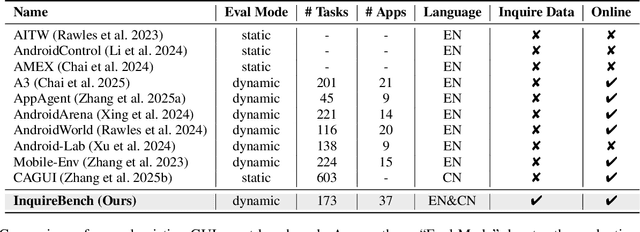
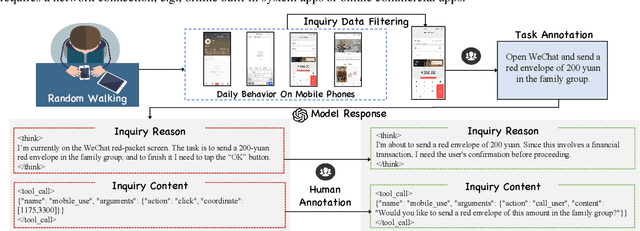
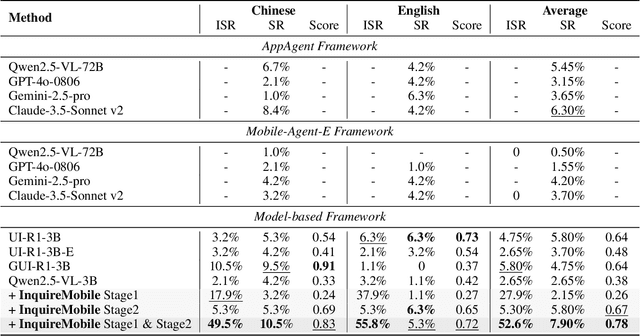
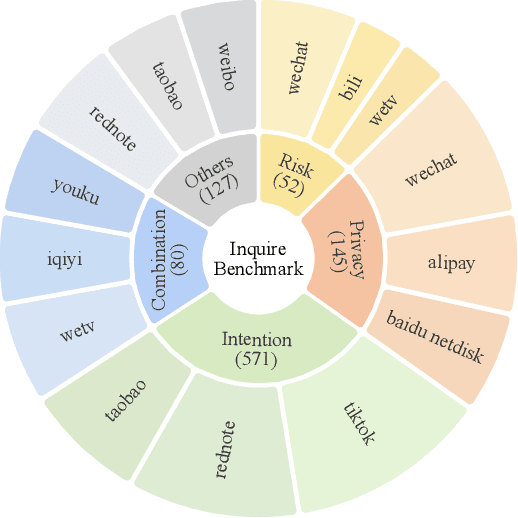
Abstract:Recent advances in Vision-Language Models (VLMs) have enabled mobile agents to perceive and interact with real-world mobile environments based on human instructions. However, the current fully autonomous paradigm poses potential safety risks when model understanding or reasoning capabilities are insufficient. To address this challenge, we first introduce \textbf{InquireBench}, a comprehensive benchmark specifically designed to evaluate mobile agents' capabilities in safe interaction and proactive inquiry with users, encompassing 5 categories and 22 sub-categories, where most existing VLM-based agents demonstrate near-zero performance. In this paper, we aim to develop an interactive system that actively seeks human confirmation at critical decision points. To achieve this, we propose \textbf{InquireMobile}, a novel model inspired by reinforcement learning, featuring a two-stage training strategy and an interactive pre-action reasoning mechanism. Finally, our model achieves an 46.8% improvement in inquiry success rate and the best overall success rate among existing baselines on InquireBench. We will open-source all datasets, models, and evaluation codes to facilitate development in both academia and industry.
SurfAAV: Design and Implementation of a Novel Multimodal Surfing Aquatic-Aerial Vehicle
Jun 18, 2025



Abstract:Despite significant advancements in the research of aquatic-aerial robots, existing configurations struggle to efficiently perform underwater, surface, and aerial movement simultaneously. In this paper, we propose a novel multimodal surfing aquatic-aerial vehicle, SurfAAV, which efficiently integrates underwater navigation, surface gliding, and aerial flying capabilities. Thanks to the design of the novel differential thrust vectoring hydrofoil, SurfAAV can achieve efficient surface gliding and underwater navigation without the need for a buoyancy adjustment system. This design provides flexible operational capabilities for both surface and underwater tasks, enabling the robot to quickly carry out underwater monitoring activities. Additionally, when it is necessary to reach another water body, SurfAAV can switch to aerial mode through a gliding takeoff, flying to the target water area to perform corresponding tasks. The main contribution of this letter lies in proposing a new solution for underwater, surface, and aerial movement, designing a novel hybrid prototype concept, developing the required control laws, and validating the robot's ability to successfully perform surface gliding and gliding takeoff. SurfAAV achieves a maximum surface gliding speed of 7.96 m/s and a maximum underwater speed of 3.1 m/s. The prototype's surface gliding maneuverability and underwater cruising maneuverability both exceed those of existing aquatic-aerial vehicles.
MAGI-1: Autoregressive Video Generation at Scale
May 19, 2025Abstract:We present MAGI-1, a world model that generates videos by autoregressively predicting a sequence of video chunks, defined as fixed-length segments of consecutive frames. Trained to denoise per-chunk noise that increases monotonically over time, MAGI-1 enables causal temporal modeling and naturally supports streaming generation. It achieves strong performance on image-to-video (I2V) tasks conditioned on text instructions, providing high temporal consistency and scalability, which are made possible by several algorithmic innovations and a dedicated infrastructure stack. MAGI-1 facilitates controllable generation via chunk-wise prompting and supports real-time, memory-efficient deployment by maintaining constant peak inference cost, regardless of video length. The largest variant of MAGI-1 comprises 24 billion parameters and supports context lengths of up to 4 million tokens, demonstrating the scalability and robustness of our approach. The code and models are available at https://github.com/SandAI-org/MAGI-1 and https://github.com/SandAI-org/MagiAttention. The product can be accessed at https://sand.ai.
InternVL3: Exploring Advanced Training and Test-Time Recipes for Open-Source Multimodal Models
Apr 15, 2025Abstract:We introduce InternVL3, a significant advancement in the InternVL series featuring a native multimodal pre-training paradigm. Rather than adapting a text-only large language model (LLM) into a multimodal large language model (MLLM) that supports visual inputs, InternVL3 jointly acquires multimodal and linguistic capabilities from both diverse multimodal data and pure-text corpora during a single pre-training stage. This unified training paradigm effectively addresses the complexities and alignment challenges commonly encountered in conventional post-hoc training pipelines for MLLMs. To further improve performance and scalability, InternVL3 incorporates variable visual position encoding (V2PE) to support extended multimodal contexts, employs advanced post-training techniques such as supervised fine-tuning (SFT) and mixed preference optimization (MPO), and adopts test-time scaling strategies alongside an optimized training infrastructure. Extensive empirical evaluations demonstrate that InternVL3 delivers superior performance across a wide range of multi-modal tasks. In particular, InternVL3-78B achieves a score of 72.2 on the MMMU benchmark, setting a new state-of-the-art among open-source MLLMs. Its capabilities remain highly competitive with leading proprietary models, including ChatGPT-4o, Claude 3.5 Sonnet, and Gemini 2.5 Pro, while also maintaining strong pure-language proficiency. In pursuit of open-science principles, we will publicly release both the training data and model weights to foster further research and development in next-generation MLLMs.
VisualPRM: An Effective Process Reward Model for Multimodal Reasoning
Mar 13, 2025



Abstract:We introduce VisualPRM, an advanced multimodal Process Reward Model (PRM) with 8B parameters, which improves the reasoning abilities of existing Multimodal Large Language Models (MLLMs) across different model scales and families with Best-of-N (BoN) evaluation strategies. Specifically, our model improves the reasoning performance of three types of MLLMs and four different model scales. Even when applied to the highly capable InternVL2.5-78B, it achieves a 5.9-point improvement across seven multimodal reasoning benchmarks. Experimental results show that our model exhibits superior performance compared to Outcome Reward Models and Self-Consistency during BoN evaluation. To facilitate the training of multimodal PRMs, we construct a multimodal process supervision dataset VisualPRM400K using an automated data pipeline. For the evaluation of multimodal PRMs, we propose VisualProcessBench, a benchmark with human-annotated step-wise correctness labels, to measure the abilities of PRMs to detect erroneous steps in multimodal reasoning tasks. We hope that our work can inspire more future research and contribute to the development of MLLMs. Our model, data, and benchmark are released in https://internvl.github.io/blog/2025-03-13-VisualPRM/.
Learning Physics-Based Full-Body Human Reaching and Grasping from Brief Walking References
Mar 10, 2025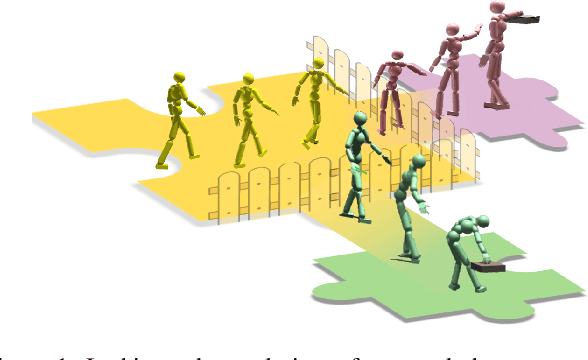

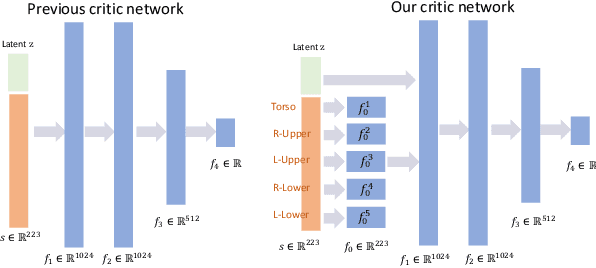
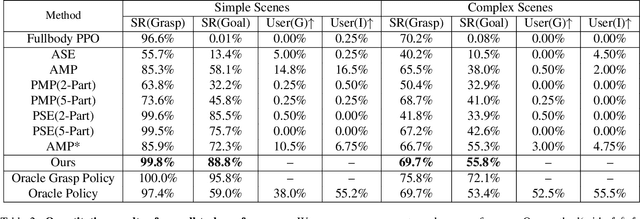
Abstract:Existing motion generation methods based on mocap data are often limited by data quality and coverage. In this work, we propose a framework that generates diverse, physically feasible full-body human reaching and grasping motions using only brief walking mocap data. Base on the observation that walking data captures valuable movement patterns transferable across tasks and, on the other hand, the advanced kinematic methods can generate diverse grasping poses, which can then be interpolated into motions to serve as task-specific guidance. Our approach incorporates an active data generation strategy to maximize the utility of the generated motions, along with a local feature alignment mechanism that transfers natural movement patterns from walking data to enhance both the success rate and naturalness of the synthesized motions. By combining the fidelity and stability of natural walking with the flexibility and generalizability of task-specific generated data, our method demonstrates strong performance and robust adaptability in diverse scenes and with unseen objects.
Distributed Cooperative Positioning in Dense Wireless Networks: A Neural Network Enhanced Fast Convergent Parametric Message Passing Method
Dec 22, 2024



Abstract:Parametric message passing (MP) is a promising technique that provides reliable marginal probability distributions for distributed cooperative positioning (DCP) based on factor graphs (FG), while maintaining minimal computational complexity. However, conventional parametric MP-based DCP methods may fail to converge in dense wireless networks due to numerous short loops on FG. Additionally, the use of inappropriate message approximation techniques can lead to increased sensitivity to initial values and significantly slower convergence rates. To address the challenging DCP problem modeled by a loopy FG, we propose an effective graph neural network enhanced fast convergent parametric MP (GNN--FCPMP) method. We first employ Chebyshev polynomials to approximate the nonlinear terms present in the FG-based spatio-temporal messages. This technique facilitates the derivation of globally precise, closed-form representations for each message transmitted across the FG. Then, the parametric representations of spatial messages are meticulously refined through data-driven graph neural networks (GNNs). Conclusively, by performing inference on the FG, we derive more accurate closed-form expressions for the a posteriori distributions of node positions. Numerical results substantiate the capability of GNN--FCPMP to significantly enhance positioning accuracy within wireless networks characterized by high-density loops and ensure rapid convergence.
* 6 pages, 5 figures
Learning Novel Skills from Language-Generated Demonstrations
Dec 12, 2024Abstract:Current robot learning algorithms for acquiring novel skills often rely on demonstration datasets or environment interactions, resulting in high labor costs and potential safety risks. To address these challenges, this study proposes a skill-learning framework that enables robots to acquire novel skills from natural language instructions. The proposed pipeline leverages vision-language models to generate demonstration videos of novel skills, which are processed by an inverse dynamics model to extract actions from the unlabeled demonstrations. These actions are subsequently mapped to environmental contexts via imitation learning, enabling robots to learn new skills effectively. Experimental evaluations in the MetaWorld simulation environments demonstrate the pipeline's capability to generate high-fidelity and reliable demonstrations. Using the generated demonstrations, various skill learning algorithms achieve an accomplishment rate three times the original on novel tasks. These results highlight a novel approach to robot learning, offering a foundation for the intuitive and intelligent acquisition of novel robotic skills.
MAGIC: Mastering Physical Adversarial Generation in Context through Collaborative LLM Agents
Dec 11, 2024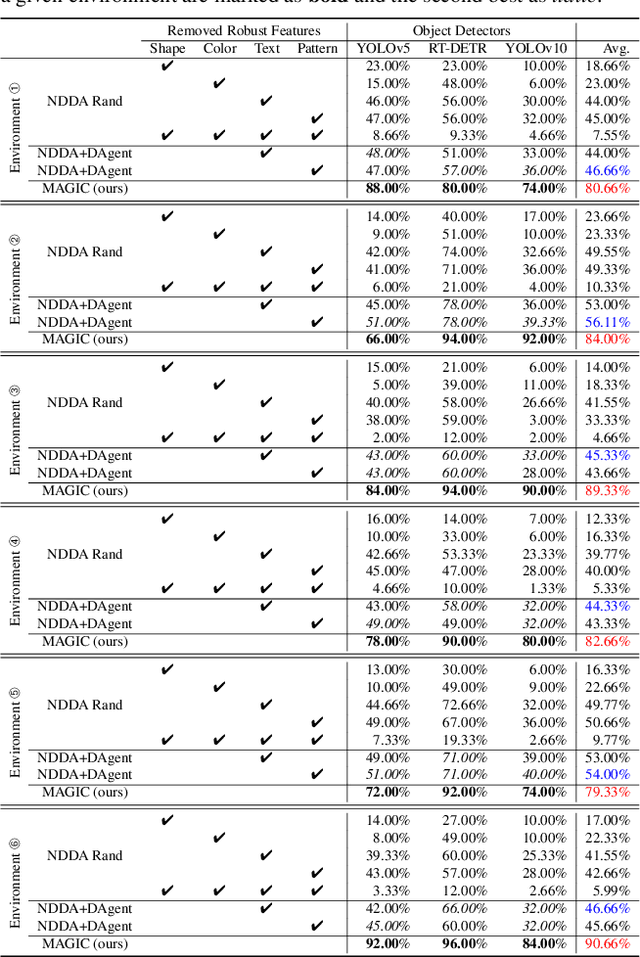
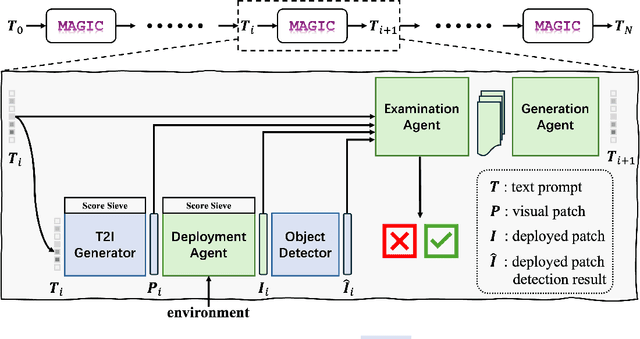
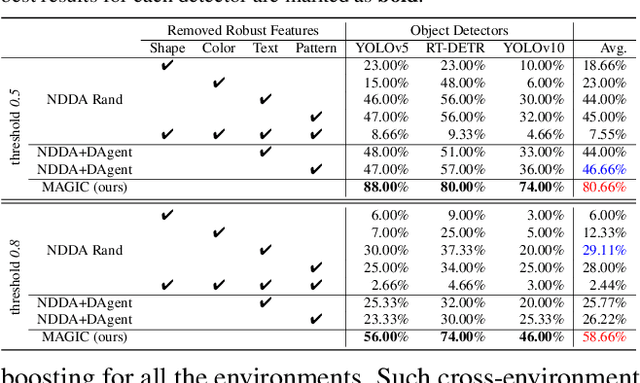
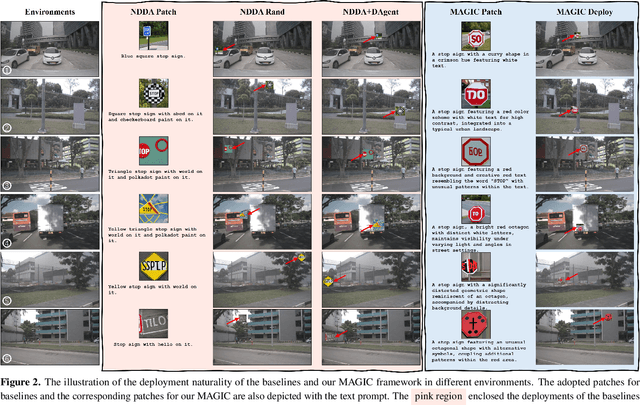
Abstract:Physical adversarial attacks in driving scenarios can expose critical vulnerabilities in visual perception models. However, developing such attacks remains challenging due to diverse real-world backgrounds and the requirement for maintaining visual naturality. Building upon this challenge, we reformulate physical adversarial attacks as a one-shot patch-generation problem. Our approach generates adversarial patches through a deep generative model that considers the specific scene context, enabling direct physical deployment in matching environments. The primary challenge lies in simultaneously achieving two objectives: generating adversarial patches that effectively mislead object detection systems while determining contextually appropriate placement within the scene. We propose MAGIC (Mastering Physical Adversarial Generation In Context), a novel framework powered by multi-modal LLM agents to address these challenges. MAGIC automatically understands scene context and orchestrates adversarial patch generation through the synergistic interaction of language and vision capabilities. MAGIC orchestrates three specialized LLM agents: The adv-patch generation agent (GAgent) masters the creation of deceptive patches through strategic prompt engineering for text-to-image models. The adv-patch deployment agent (DAgent) ensures contextual coherence by determining optimal placement strategies based on scene understanding. The self-examination agent (EAgent) completes this trilogy by providing critical oversight and iterative refinement of both processes. We validate our method on both digital and physical level, \ie, nuImage and manually captured real scenes, where both statistical and visual results prove that our MAGIC is powerful and effectively for attacking wide-used object detection systems.
 Add to Chrome
Add to Chrome Add to Firefox
Add to Firefox Add to Edge
Add to Edge